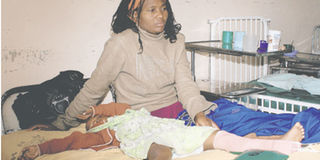No play field? Your child faces health risk

JENNIFER MUIRURI | NATION
Dorcas Kyalo and her injured daughter Catherine Mumo in the children’s orthopaedic ward at the Kenyatta National Hospital on Friday.
Children love to run, hop, skip and jump – and they often take a tumble. But, with increasing sedentary lifestyles in urban settings, parents have reason to worry.
Doctors are concerned that as open playing spaces disappear and children spend more time indoors, they are losing the chance to develop healthy bones and to play safely.
But Prof Lawrence Gakuu, a lecturer in the Department of Orthopaedic Surgery at the University of Nairobi School of Medicine, advises against limiting children’s outdoor play, even as he stresses the importance of open playing fields.
“The risk of injury increases when you restrict children from playing,” he warned.
Sample this. When three-year-old Catherine Mumo’s younger sister, Michelle, came running into the house and accidentally slammed the door on Catherine, initially it seemed like innocent child’s play.
Five minutes later, little Catherine’s left leg was swollen.
Dorcas Kyalo rushed her daughter to the nearest dispensary in Kawangware, but the doctor referred her to Kenyatta National Hospital for further examination.
“The door applied pressure on her left leg, and she let out a sharp cry in pain and then sat down unable to move,” her mother told the Sunday Nation.
Upon examination, Catherine was found to have suffered a fracture on her left foot and was admitted to hospital on Tuesday night.
Minor injuries during playtime, falls, neglect or physical abuse or road accidents are examples of things that can cause bone fractures in children.
Kenya Orthopaedic Association chairman Dr Fred Otsyeno stresses the importance of playtime, saying playful children are energetic and later grow up to become very productive people in the society.
While concurring with Dr Otsyeno, Prof Gakuu further stressed the importance of children playing outdoors in the sun to get their share of vitamin D that promotes the healthy development of bones.
Without sufficient vitamin D, bones can become thin or brittle. Vitamin D sufficiency prevents rickets in children and osteomalacia in adults. Most people meet at least some of their vitamin D needs through exposure to sunlight.
Dr Otsyeno says broken limbs are common in children between five and eight years, especially boys.
“It is only natural for children to play. However, they should be supervised to avoid serious injuries,” Dr Otsyeno told the Sunday Nation.
But he said that treating injuries sustained by children should be done immediately to prevent complications that could arise from fractures that were ignored when the child was young.
When the Sunday Nation visited Catherine yesterday at bed Number 4 in Ward 6A at KNH, the little girl’s leg was in traction, which would help in her recovery.
Traction is force applied by weights or other devices to treat bone or muscle disorders or injuries.
The weights – typically five to seven pounds – are attached to the skin using tape, straps, or boots.
They bring together the fractured bone or dislocated joint so that it heals correctly.
Most fractures occur in the upper extremities – the wrist, the forearm and above the elbow.
Some of the preventive measures that parents, guardians and teachers can take include encouraging children to wear protective gear for racquet sports, bicycle riding, hockey and other games that carry a higher risk of injuries.
A paper presented at a Kenya Orthopaedics Association seminar in Naivasha a fortnight ago singles out fractures of the elbow as the most common in children from one to 12 years.
A study carried out by Dr Otsyeno and others at KNH to determine the pattern of injuries in children revealed that more boys than girls were affected.
“Supracondylar fractures of the humerus (fractures of the elbow) are a common finding in children reporting trauma to the elbow such as a fall on an outstretched hand, commoner in males than females,” according to findings from the study carried out between January and April this year.
Veronica Cherono, 31, now suffers from a case of delayed reaction from when she fell off a lorry she had tried to jump onto when she was 10.
Two decades later, the problem recurred as pains in her thigh.
The pain became intense and, upon visiting a bone specialist, she was informed that the injury was caused by that fall 20 years ago.
“At the time my parents took me to the dispensary, and they gave me pain killers and sent me home,” Ms Cherono said.
Even though Catherine will be in hospital for another three weeks, Ms Kyalo is grateful that she took her daughter there in time, and she is assured of full recovery.




